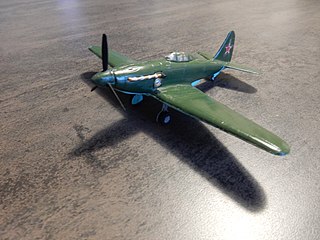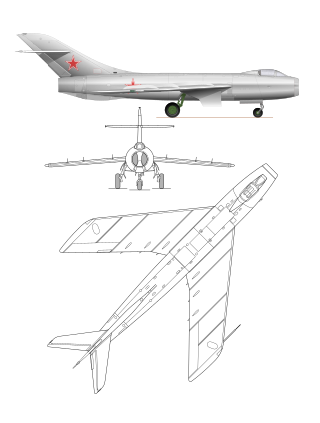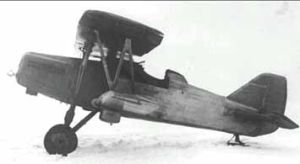Related Research Articles

The Mikoyan-Gurevich I-250, aka MiG-13, was a Soviet fighter aircraft developed as part of a crash program in 1944 to develop a high-performance fighter to counter German turbojet-powered aircraft such as the Messerschmitt Me 262. The Mikoyan-Gurevich design bureau decided to focus on a design that used something more mature than the jet engine, which was still at an experimental stage in the Soviet Union, and chose a mixed-power solution with the VRDK motorjet powered by the Klimov VK-107 V12 engine. While quite successful when it worked, with a maximum speed of 820 km/h (510 mph) being reached during trials, production problems with the VRDK fatally delayed the program and it was canceled in 1948 as obsolete.

The Sukhoi Su-2 was a Soviet reconnaissance and light bomber aircraft used in the early stages of World War II. It was the first airplane designed by Pavel Sukhoi. The basic design received an engine and armament upgrade (Su-4) and was modified for the ground-attack role (ShB).

The Yakovlev Yak-3 was a single-engine, single-seat World War II Soviet fighter. Robust and easy to maintain, it was much liked by both pilots and ground crew. One of the smallest and lightest combat fighters fielded by any combatant during the war, its high power-to-weight ratio gave it excellent performance and it proved to be a formidable dogfighter.

The Tupolev I-12 was a prototype Soviet fighter aircraft that never reached production. The I-12 was of unconventional design with twin booms made of water pipes containing recoilless rifles and two engines in a push-pull configuration. The aircraft first flew in 1931 but did not enter production due to disappointing performance and operational difficulties such as the inability for the pilot to escape the aircraft without hitting the propeller arc behind him. The second prototype from Tupolev was never completed.

The Klimov VK-107 was a V-12 liquid-cooled piston aircraft engine used by Soviet aircraft during World War II.

The Sukhoi Su-6 was a Soviet ground-attack aircraft developed during World War II. The mixed-power high-altitude interceptor Su-7 was based on the single-seat Su-6 prototype.
The Sukhoi Su-10 or Izdeliye Ye was a Soviet turbojet-powered bomber aircraft built shortly after World War II.
The Sukhoi Su-8 or DDBSh was a Soviet prototype ground-attack aircraft of World War II.

The Sukhoi Su-1 or I-330 was a prototype Soviet high-altitude fighter aircraft built at the beginning of World War II. An improved version, designated Su-3 (I-360), was also built and tested the following year. Neither version was mass-produced.

The Sukhoi Su-12 was a prototype Soviet reconnaissance and artillery spotter aircraft developed during World War II.

The Sukhoi Su-15 was a prototype Soviet all-weather interceptor which never reached production.

The Sukhoi Su-17 was a prototype Soviet fighter. The name was later reused for an entirely different fighter-bomber, see Sukhoi Su-17.

Yakovlev Yak-50 was an early experimental turbojet interceptor aircraft designed in 1948 by the Yakovlev OKB in the USSR. The aircraft was essentially a stretched version of the Yakovlev Yak-30 (1948), with a more powerful engine and greater wing sweep. The Yak-50 is perhaps most significant as the first Yakovlev aircraft equipped with velosipednoye (bicycle) landing gear, a trademark of later Yakovlev designs. The Yak-50 designation was later reused for a propeller-driven aerobatic and trainer aircraft.

The Grigorovich I-Z was a fighter aircraft developed in the Soviet Union during the 1930s. Advances in aircraft survivability thanks to all-metal construction and self-sealing and inert gas-filled fuel tanks led to experimentation with large-caliber weapons to shoot them down. In Soviet Union, Leonid Kurchevsky developed a series of recoilless rifles in various calibers and in 1930 was decided to adapt the 76.2 mm (3 in) weapons for aircraft use.

The Tupolev I-8 was an experimental interceptor built in the Soviet Union in the early 1930s.

The Polikarpov TB-2 was a Soviet heavy bomber prototype designed and tested in the 1920s. It was a sesquiplane of wooden construction, with engines mounted on the bottom wing. Work on the sole prototype began in 1927 and it was tested in 1930. Although TB-2 performance was superior to that of the Tupolev TB-1 in service at the time, it was deemed insufficient for 1930 and the project was abandoned.

The Grigorovich DI-3, , was a prototype two-seat fighter developed in the Soviet Union in the 1930s. It was intended to be a long-range escort fighter developed from the DI-2 with improved range and performance comparable to single-seat fighter aircraft of the time. DI-3 was a single-bay biplane of mixed construction with a twin-rudder tailplane of variable incidence.

The Laville DI-4 was a prototype two-seat fighter aircraft developed in the Soviet Union in the 1930s. The chief designer Henri Laville was one of several French aviation specialists invited to work in the Soviet Union and not surprisingly the DI-4 layout was typical of the French trend at the time with the first high-mounted gull wing on a Soviet aircraft and all-metal construction.

The Lavochkin La-200 was a two-seater, swept winged, night/all-weather jet prototype designed as an interceptor and manufactured by the Soviet Union's Lavochkin Design Bureau from 1948.

The Kholshchevnikov VRDK(Russian: "Jet-Propelled Auxiliary Compressor”) was a motorjet developed in the Soviet Union during World War II. The VRDK was designed to give fighter aircraft a 10 minute performance boost during combat.
References
- 1 2 3 Shavrov V.B. (1994). Istoriia konstruktskii samoletov v SSSR, 1938–1950 gg. (3 izd.). Mashinostroenie. ISBN 5-217-00477-0.
- 1 2 Green, W; Swanborough, G (2001). The Great Book of Fighters. MBI Publishing. ISBN 0-7603-1194-3.
- ↑ "Sukhoi Su-5". Sukhoi Company Museum. Archived from the original on 2006-11-18. Retrieved 2007-01-14.
- ↑ Antonov, Vladimir; Gordon, Yefim; Gordyukov, Nikolai; Yakovlev, Vladimir; Zenkin, Vyacheslav; Carruth, Lenox; Miller, Jay (1996). OKB Sukhoi : a history of the design bureau and its aircraft (1st ed.). Earl Shilton: Midland Publishing. p. 69. ISBN 9781857800128.
- ↑ Lednicer, David. "The Incomplete Guide to Airfoil Usage". m-selig.ae.illinois.edu. Retrieved 16 April 2019.